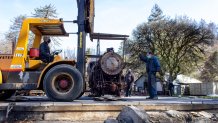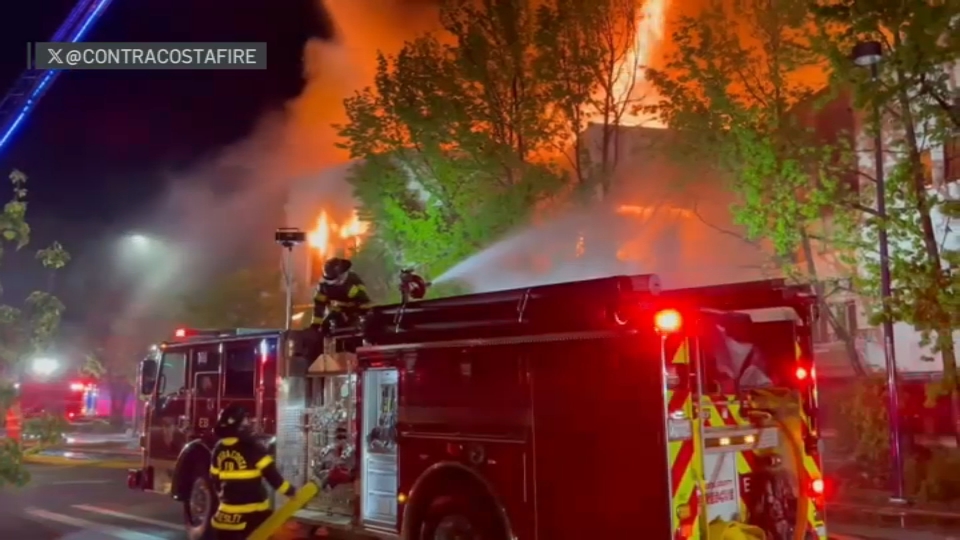Volunteers hoping to restore the fire-damaged historic Swanton Pacific Railroad in the Santa Cruz mountains were dismayed this week to learn the university in possession of the land is aborting plans to rebuild.
A dean with Cal Poly University informed the volunteer-run Swanton Pacific Railroad Society by email the school intends to donate the antique steam-engines and equipment to an outside organization, rather than rebuild and operate the popular railroad that's run on the land since the 1980s. The school said it would instead focus on educational pursuits on the land.
"Though invaluable from a historical perspective," wrote Dr. Andrew Thulin, dean of Cal Poly's School of Agriculture, Food and Environmental Sciences, "the railroad does not fit within the strategic intent of the ranch when viewed through that lens."
The railroad -- featuring steam engines built for the 1915 Panama Pacific International Exposition -- was badly damaged in the 2020 CZU Lightning Complex Fire. The wildfire scorched tracks, historic buildings and three of the original engines. A fourth engine was away for repairs at the time of the fire.
Get a weekly recap of the latest San Francisco Bay Area housing news. Sign up for NBC Bay Area’s Housing Deconstructed newsletter.
Volunteers who maintained the rustic railroad hoped to work with the university to rebuild the engines and get the railroad operational again but the announcement scuttled those hopes, at least as far as the current ranch site.

"It looks like we’ve had a really good run," said longtime volunteer Molly Engelman, "but Cal Poly has other ideas now which is really unfortunate."
Local
The engines, which ran during the 1915 fair, became scattered across the state over the years. Al Smith, founder of Orchard Supply Hardware, collected the engines together again and created the working railroad on his sprawling wooded ranch not far from Santa Cruz. When Smith died in the early 1990s, he donated the ranch and railroad to his alma mater Cal Poly. Volunteers continued to maintain and operate the trains until the fire.
"When Al Smith gifted the ranch and the railroad to Cal Poly," Engelman said, "it was his understanding at the time that that was going to be the best home for his railroad and his ranch."
In his letter to the society, Thulin called it a difficult decision to abandon operations at the site. He said the university would seek an organization to take the remaining railroad assets -- though no specific group had been identified. He mentioned the California State Railroad Museum in Sacramento as a potential beneficiary though he didn't indicate whether the university had yet contacted the museum. He also raised the possibility the collection might be split up.
"Cal Poly firmly believes that getting these invaluable assets into the hands of an entity whose core mission it is to restore and care for them and make them once again available to the public will be best in the long run and is what Swanton Pacific Ranch donor Al Smith would have wanted," Thulin wrote, noting that a consultant had estimated the price tag for rebuilding the railroad at $10 million.
But Engelman believes Smith would have been aghast to see his collection donated and dispersed.
"I can just picture Al rolling over in his grave knowing that information," said Engelman who's volunteered with the railroad since she was three-years old.
Engelman said another slap in the face to volunteers was the recent discovery the land managers had changed the locks on all railroad facilities at the ranch. University officials declined a request for an interview, instead steering inquiries to its letter.
Following the fire, those volunteers who had maintained the railroad for decades were once-again rolling up their sleeves to pitch-in with the rebuilding. But they said communication with the university was spotty, and opportunities to return to the site were sparse.
Engelman noted many of the railroad's supporters donated to a crowdfund created by Cal Poly to support the ranch restoration. Cal Poly said those funds would now go toward relocating the collection.
Engelman had hoped the crowdfund effort was a sign of the university's commitment toward rebuilding. But following the new information, it became clear the railroad had most likely ridden its last rail on the ranch. The university said it would use the land to focus on educational purposes, teaching management and stewardship of working landscapes.
But for Engelman and other volunteers, the likely demise of the railroad in its current location, felt like a breach of Smith's intent.
"It very much goes against what Al Smith wanted," she said.



